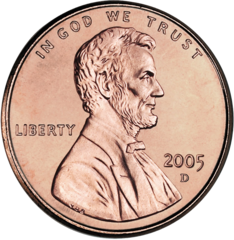The last generation of Canadian pennies is being struck out of copper-plated steel. The American penny is made of a similar structure, copper-plated zinc. In both cases, the corrosion-resistant copper is used to shield a less durable metal from the dangers of the outside world. The problem is that it now costs both the Canadian and American governments more than a cent to make a cent. According to the report cited above, the Canadian government pulled the plug when it cost 1.6¢. However, the US mint is grimly plugging along when it costs 1.92¢ (as of 2010). They're also losing money on the nickel (9.22¢ to make), something the Canadian government proudly boasts is not a problem.
The US mint is looking at again reformulating the penny, which was 95% copper until 1982, when it switched to copper-plated zinc. Meanwhile, there are people hoarding the old pennies, waiting for the day they can legally melt them down for the copper content.
Zinc is a light white metal usually used in galvanized steel, bulk castings and roofing. Both zinc and steel are used as fillers in pennies because there's more than a penny's worth of copper in a copper penny. While zinc is used to protect steel as a sacrificial coating (think the short-lived shininess of new guardrails on the interstate), it is not particularly durable in and of itself, and will develop a crusty white coating of zinc oxide. For that reason, pure zinc wouldn't work for a coin that's handled regularly. Nor would pure steel or regular iron. That leaves only one metal cheap enough: Aluminum.
That's what an aluminum penny would look like. A test series was struck in 1973 when copper became too expensive. If the US Mint hangs onto the penny much longer, it will probably have to resort to something like this again, although it's hard to say. The problem with the nickel might be a bit easier to solve; the nickel could just be made from zinc and nickel plated.
For now, it's all talk. But sooner or later, something is going to have to give. The Canadian method, interestingly enough, is to leave the pennies as legal tender and let people decide what to do for themselves.


